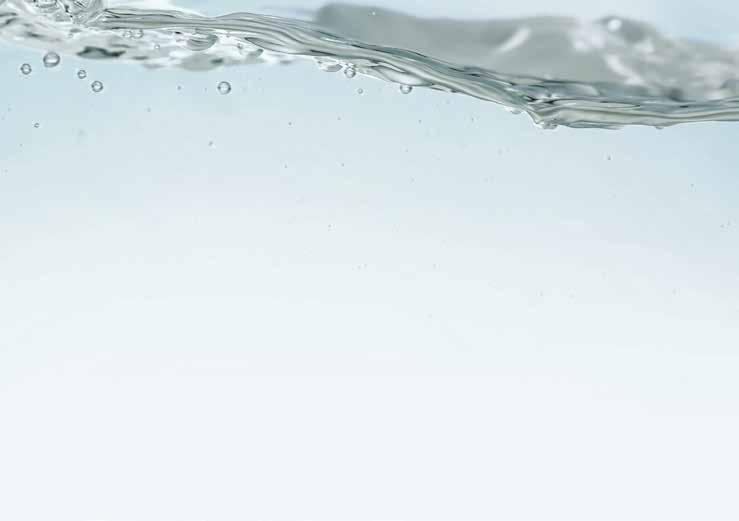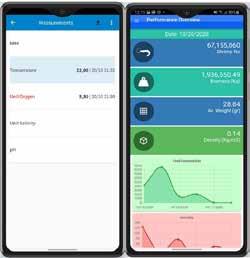
9 minute read
Empowering the shrimp sector through digital transformation
How an advanced production management software can be the first step towards production optimisation and sustainability.
By Konstantinos Bovolis
Aquaculture is an expanding industry that has great potential to address the demand for high quality protein along with the increasing global population and income. However, while the biomass produced from aquaculture has already surpassed that of fisheries for direct human consumption there is a feeling that the industry is slow to adopt technology and reap its benefits, especially in comparison with other segments of food production, such as poultry. While large strides and technological breakthroughs have been made in the past decades, especially in salmon farming, some sectors, such as shrimp farming are still lagging in terms of adoption of technology. Although having a long history and tradition, shrimp producers, regardless of whether they are small local farms or huge multinational companies, are still relying on experience and instinct, when it comes to decision making and daily operations.
In an everchanging environment and in a world that is constantly evolving, the need for control, innovation, standardisation, automation and sustainability is more profound than ever. The Covid-19 pandemic, accompanied by the initial market shocks, have demonstrated the urgency to address these needs.
Making the right decisions in terms of production cost, -quality, and -scheduling can make the difference between profit and loss. This is especially the case in the shrimp industry, characterised by short production cycles, considerable product price sensitivity, and reliance on optimal environmental conditions for shrimp growth and survival. The daily challenge of controlling shrimp production in real time for maximum profitability and environmental sustainability, can be overcome if supported by a dedicated production management software.
Functionalities adapted to the company’s needs
The recording and interpretation of various parameters, such as stocking density, feed conversion ratios, health status and survival rates, may differ from farm to farm and can be unique among different production systems and producers. For instance, some production units might register their data in kilogram per hectare, while others would work with data in square meters or even cubic meters. Also, managers might have different preferences on how data and reports are presented, analysed and visualised. An advanced management software allows users to personalise and customise all its functionalities to reflect the production reality of each farm and perfectly align the program's functionalities with the company’s objectives and needs.
Feed management and evaluation of daily operations using mobile devices
The use of sinking feeds and subjective survival estimation pose many challenges for efficient pond management. At the same time, the short production cycle demands very frequent (weekly, in most cases) survival estimations and weight sampling, together with continuous biomass and feeding regime adaptations and updates. Tools to support rapid and accurate adjustments to the daily feeding and continuous fine-tuning of the optimal feeding regimes are a must and should be readily available to the farm manager.
Nowadays, shrimp farms rely mainly on hand-written feed registration and control systems. Although this practice might seem handy, cheap and fitting the level of education of the farm’s workforce, it is not befitting the shrimp company’s continuous drive for better controls in search of profitability and quality certifications. Handwritten data collection is prone to errors and puts a huge burden on the farm manager’s shoulders as he is not able to see all required information in a consolidated format. Processing the data can be very time consuming and poses difficulties in demonstrating conformity during the ever more frequent
audits.
Figure 1. Accurate data collection and reporting through mobile applications provide accesible information in a consolidated format.
With most of the work force familiar with smartphones and with the help of user friendly dedicated mobile applications and considerably basic training, the farm operators are able to register critical information directly on the field. Feeding, mortalities, water quality and issues in specific ponds or the whole farm can be accurately registered in real time, reducing errors and assuring that the system is always updated, providing total traceability at all times (Figure 1).
Figure 2. Farm and pond production overview screen

Production overview
Managers can monitor what is happening in real time and evaluate the performance of the personnel or even make spontaneous adjustments. Through powerful overview screens (Figure 2) that mirror the reality in the field, the managers have a “cockpit” in front of them to make the best-informed decisions.
The use of mobile devices with production management software has already changed the way shrimp companies in several countries are working. Farm technicians can perform the daily tasks in a faster and more efficient way, while managers have more time to focus on important tasks and production optimisation.
Even the most advanced software will never replace a good manager, in fact, it merely becomes his/her “best friend”, as it empowers both the management and the personnel, by providing tools to assist the decisionmaking process in real time and to clearly demonstrate the results. Real time notification to the supervisors in case of a problem and the ability to generate management reports immediately, allow production managers to save time, reduce paperwork and increase efficiency.
Data Reliability and Modelling
Average shrimp weight samplings and pond density estimations are quite common in shrimp production. An accurate dataset consisting of production information between a period of any two samplings can be valuable in terms of a descriptive analysis of the production and further predictive analysis through accurate modelling. And here is where things get interesting! Each datum is unique and processes tremendous power when combined and analysed alongside other data.
A production management system ensures data validity, integrity and accessibility. This data can be used to engineer models, such as growth models or survival and feeding tables based on the actual data from the specific farm, tailored to the local conditions and production systems (Figure 3). These are not generic models or ones that are based on intuition, but accurate and personalised models that can even be used on the fly to run multiple production plans. Thus, the production manager can optimise future production, while at the same time reduce feed- and operational costs.

Figure 4. Hatchery Module showing costs breakdown.
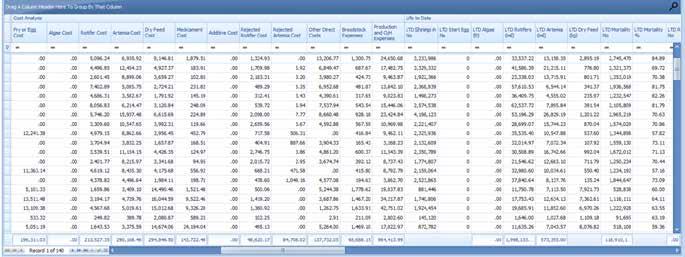
Hatchery Module - traceability
Production control, traceability and cost analysis can go all the way back to the broodstock, through a dedicated hatchery module. A hatchery software module consists of specific departments for broodstock, hatching and incubation, live feed (algae and artemia) all the way to shrimp post larvae that are ready to be moved to nursery and grow out (Figure 4). Full traceability of both consumptions and population transfers in all departments can be achieved seamlessly.
For companies that operate both hatcheries and grow-out farms, the “Grow-out module” is automatically integrated with the “Hatchery Module”, assuring that every piece of information throughout the shrimp life is easily accessible and secured. Certification bodies are focusing more and more on details to ensure product quality and full traceability. By using management software, documented and accurate replies to queries, as well as accurate post larvae costs, are just a couple of mouse clicks away.
Cost analysis
Data reliability, error prevention mechanisms, traceability and inventory/storeroom management, not only reinforce production control but also allow a very accurate and automatic cost allocation.
Besides the direct costs, such as feed, probiotics, fertiliser etc., other production expenses and overheads (chart of accounts) can be either registered directly on the system or automatically imported through an integration with an enterprise resource planning (ERP) or accounting system.
A production software can allocate those costs on shrimp number basis, biomass or other more advanced ways. The result is an analytical breakdown of the cost into multiple components, i.e. total cost, remaining cost, post larvae cost, feed cost, harvest cost, mortality cost, cost of goods sold, adjustment cost and many more.
Additional benefits
Data integrity minimises the uncertainty and contributes to more accurate production and financial plans. The quality and validity of the collected data, whether they are registered at the field through mobile devices, or collected through integration of IoT devices, such as continuous water quality monitoring probes or feeding equipment, is ensured (Figure 5). A robust management software enables fraud detection and identification of false data (outliers). This minimises the uncertainty and contributes to a more accurate biological and financial planning.
Figure 5. Real time water quality measurements with IoT devices.
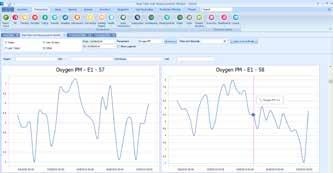
Visualisation of data and easily accessible analysis can assist in problem Identification and prevention of issues before they escalate. Timely identification of trends and patterns in production can make a huge difference and ensure profitability, especially when dealing with the short production cycles in shrimp. The success of shrimp production is affected by a multitude of factors of varying scope and impact, from the stocking density to feed composition, production practices, people and more.
A production management software allows producers to identify systematic relationships between the variables that affect production and dramatically improve sustainable production (Figure 6). Without a system in place, it is nearly impossible to quantify those relationships and focus on the areas that could potentially bring performance improvement. Feed and hatchery evaluation capabilities make it easier to select the best feeds and post larvae quality.
Operational efficiency through the establishment of workflows is one of the biggest advantages that can come with IT. Easier communication across all production levels and a better organised way of working can have a positive effect on the motivation and performance of the staff.
Figure 6. Feed performance comparison chart
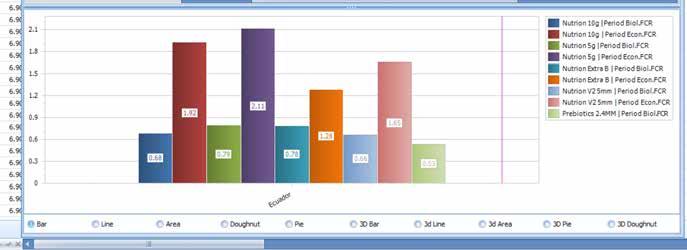
Next day
Accurate data analysis and predictive modelling can provide each individual farm and the entire sector the capability to better understand the knowledge that can be extracted from a huge amount of data (environmental parameters, feed types, feed composition, feeding rates and practices, production management practices, etc.). From this data, educated assessments will influence the decision-making process and lead to greater efficiency and subsequently result in a faster return on investments (Figure 7). If one registers all the information, some significantly relevant results may emerge when comparing, for example, average water temperature, pond soil type, probiotics and moon phase with the prevalence of diseases. Once data are registered in a system it is possible to quickly and with very little effort evaluate a whole range of data and scenario, in search of knowledge that is both local and accurate.
The shrimp sector is still in its technological infancy. The tools and the capacity to empower shrimp producers are already available and the digital transformation is inevitable and part of our new reality. Making those tools accessible to everybody still demands some investment in IT infrastructure in many regions around the world, but solutions are evolving and getting cheaper rapidly. What lies ahead is the challenge of educating shrimp farm owners, management and technical personnel, as well as the farm workers, on how investments made to control production can generate knowledge. This knowledge can be applied to bring higher returns and sustainable growth for the industry.

Konstantinos Bovolis Bovolis is the Product Manager of the AquaManager software suite. With a degree in Computer Engineering from the University of Patras, followed by courses in web development at the National and Kapodistrian University of Athens, Greece. Konstantinos worked as a software consultant and a business development analyst before finding his true calling in the digital transformation of the aquaculture industry. He is currently pursuing an MBA at the University of Strathclyde, Scotland. Email: sales@intratecnutrition.com
Figure 7. Tools for optimal feeding and feeding strategy evaluation.









